South China Sea SST Fronts, 2015–2022
Abstract
:1. Introduction
2. Data
3. Methods
3.1. Front Detection
3.2. Front Mapping, Front Frequency, and Front Stability
3.3. Front Intensity, Front Strength, and Cross-Frontal Ranges of Oceanic Variables
3.4. Logarithmic Transformation of SST Gradient
4. Results
4.1. Sea Surface Temperature and Its Seasonal Variability: Large-Scale Pattern and Meso-Scale Features
4.1.1. Cold Tongue in Winter
4.1.2. Rapid Warming in Spring
4.1.3. Rapid Cooling in June–July
4.2. SST Gradients
4.3. Log-Transformed Gradient of SST
4.4. Region 1: Taiwan Strait
4.5. Region 2: Guangdong Shelf
4.6. Region 3: Hainan Island and Beibu Gulf
4.7. Region 4: Mekong River Outflow and Gulf of Thailand Entrance
4.8. Region 5: Luzon Strait and West of Luzon
4.9. Summertime Eastward Jet off SE Vietnam
5. Discussion
5.1. China Coastal Front
5.2. Taiwan Strait and Taiwan Bank
5.3. Eastern Guangdong Shelf
5.4. Pearl River Plume Front
5.5. Western Guangdong Shelf
5.6. Hainan Island
5.7. Beibu Gulf (Gulf of Tonkin)
5.8. Central and SE Vietnam Shelf
5.9. Summertime Eastward Jet Off SE Vietnam
5.10. Mekong Estuary and Shelf
5.11. Gulf of Thailand
5.12. Peninsular Malaysia
5.13. Sunda Shelf
5.14. Borneo Shelf
5.15. West Luzon Front
5.16. Luzon Strait
6. Conclusions
Author Contributions
Funding
Data Availability Statement
Acknowledgments
Conflicts of Interest
References
- Cayula, J.F.; Cornillon, P. Edge detection algorithm for SST images. J. Atmos. Ocean. Technol. 1992, 9, 67–80. [Google Scholar] [CrossRef]
- Cayula, J.F.; Cornillon, P. Multi-image edge detection for SST images. J. Atmos. Ocean. Technol. 1995, 12, 821–829. [Google Scholar] [CrossRef]
- Belkin, I.M.; Cornillon, P.C.; Sherman, K. Fronts in Large Marine Ecosystems. Prog. Oceanogr. 2009, 81, 223–236. [Google Scholar] [CrossRef]
- Hickox, R.; Belkin, I.; Cornillon, P.; Shan, Z. Climatology and seasonal variability of ocean fronts in the East China, Yellow and Bohai Seas from satellite SST data. Geophys. Res. Lett. 2000, 27, 2945–2948. [Google Scholar] [CrossRef]
- Wang, D.X.; Liu, Y.; Qi, Y.Q.; Shi, P. Seasonal variability of thermal fronts in the Northern South China Sea from satellite data. Geophys. Res. Lett. 2001, 28, 3963–3966. [Google Scholar] [CrossRef]
- Shimada, T.; Sakaida, F.; Kawamura, H.; Okumura, T. Application of an edge detection method to satellite images for distinguishing sea surface temperature fronts near the Japanese coast. Remote Sens. Environ. 2005, 98, 21–34. [Google Scholar] [CrossRef]
- Chang, Y.; Shimada, T.; Lee, M.A.; Lu, H.J.; Sakaida, F.; Kawamura, H. Wintertime sea surface temperature fronts in the Taiwan Strait. Geophys. Res. Lett. 2006, 33, L23603. [Google Scholar] [CrossRef]
- Chang, Y.; Lee, M.A.; Shimada, T.; Sakaida, F.; Kawamura, H.; Chan, J.W.; Lu, H.J. Wintertime high-resolution features of sea surface temperature and chlorophyll-a fields associated with oceanic fronts in the southern East China Sea. Int. J. Remote Sens. 2008, 29, 6249–6261. [Google Scholar] [CrossRef]
- Chang, Y.; Shieh, W.J.; Lee, M.A.; Chan, J.W.; Lan, K.W.; Weng, J.S. Fine-scale sea surface temperature fronts in wintertime in the northern South China Sea. Int. J. Remote Sens. 2010, 31, 4807–4818. [Google Scholar] [CrossRef]
- Lee, M.A.; Chang, Y.; Shimada, T. Seasonal evolution of fine-scale sea surface temperature fronts in the East China Sea. Deep-Sea Res. Part II 2015, 119, 20–29. [Google Scholar] [CrossRef]
- Yu, Y.; Zhang, H.R.; Jin, J.B.; Wang, Y.T. Trends of sea surface temperature and sea surface temperature fronts in the South China Sea during 2003–2017. Acta Oceanol. Sin. 2019, 38, 106–115. [Google Scholar] [CrossRef]
- Wang, Y.T.; Yu, Y.; Zhang, Y.; Zhang, H.R.; Chai, F. Distribution and variability of sea surface temperature fronts in the South China Sea. Estuar. Coast. Shelf Sci. 2020, 240, 106793. [Google Scholar] [CrossRef]
- Canny, J. A computational approach to edge detection. IEEE Trans. Pattern Anal. Mach. Intell. 1986, 8, 679–698. [Google Scholar] [CrossRef] [PubMed]
- Castelao, R.M.; Wang, Y.T. Wind-driven variability in sea surface temperature front distribution in the California Current System. J. Geophys. Res. Ocean. 2014, 119, 1861–1875. [Google Scholar] [CrossRef]
- Wang, Y.T.; Castelao, R.M.; Yuan, Y.P. Seasonal variability of alongshore winds and sea surface temperature fronts in Eastern Boundary Current Systems. J. Geophys. Res. Ocean. 2015, 120, 2385–2400. [Google Scholar] [CrossRef]
- Zhao, L.H.; Yang, D.T.; Zhong, R.; Yin, X.Q. Interannual, seasonal, and monthly variability of sea surface temperature fronts in offshore China from 1982–2021. Remote Sens. 2022, 14, 5336. [Google Scholar] [CrossRef]
- Chen, J.Y.; Hu, Z.F. Seasonal variability in spatial patterns of sea surface cold- and warm fronts over the continental shelf of the northern South China Sea. Front. Mar. Sci. 2023, 9, 1100772. [Google Scholar] [CrossRef]
- Ullman, D.S.; Cornillon, P.C. Satellite-derived sea surface temperature fronts on the continental shelf off the northeast U.S. coast. J. Geophys. Res. Ocean. 1999, 104, 23459–23478. [Google Scholar] [CrossRef]
- Ullman, D.S.; Cornillon, P.C. Continental shelf surface thermal fronts in winter off the northeast US coast. Cont. Shelf Res. 2001, 21, 1139–1156. [Google Scholar] [CrossRef]
- Xing, Q.W.; Yu, H.Q.; Wang, H.; Ito, S.I. An improved algorithm for detecting mesoscale ocean fronts from satellite observations: Detailed mapping of persistent fronts around the China Seas and their long-term trends. Remote Sens. Environ. 2023, 294, 113627. [Google Scholar] [CrossRef]
- Xing, Q.W.; Yu, H.Q.; Wang, H. Global mapping and evolution of persistent fronts in Large Marine Ecosystems over the past 40 years. Nat. Commun. 2024, 15, 4090. [Google Scholar] [CrossRef] [PubMed]
- Belkin, I.M.; Lou, S.S.; Yin, W.B. The China Coastal Front from Himawari-8 AHI SST Data—Part 1: East China Sea. Remote Sens. 2023, 15, 2123. [Google Scholar] [CrossRef]
- Belkin, I.M.; Lou, S.S.; Zang, Y.T.; Yin, W.B. The China Coastal Front from Himawari-8 AHI SST Data—Part 2: South China Sea. Remote Sens. 2024, 16, 3415. [Google Scholar] [CrossRef]
- Bessho, K.; Date, K.; Hayashi, M.; Ikeda, A.; Imai, T.; Inoue, H.; Kumagai, Y.; Miyakawa, T.; Murata, H.; Ohno, T.; et al. An introduction to Himawari-8/9—Japan’s new-generation geostationary meteorological satellites. J. Meteorol. Soc. Jpn. 2016, 94, 151–183. [Google Scholar] [CrossRef]
- Belkin, I.M.; O’Reilly, J.E. An algorithm for oceanic front detection in chlorophyll and SST satellite imagery. J. Mar. Syst. 2009, 78, 317–326. [Google Scholar] [CrossRef]
- Belkin, I.M.; Shen, X.T. Salinity fronts in the South Atlantic. Remote Sens. 2024, 16, 1578. [Google Scholar] [CrossRef]
- Liu, Q.Y.; Jiang, X.; Xie, S.P.; Liu, W.T. A gap in the Indo-Pacific warm pool over the South China Sea in boreal winter: Seasonal development and interannual variability. J. Geophys. Res. Ocean. 2004, 109, C07012. [Google Scholar] [CrossRef]
- Varikoden, H.; Samah, A.A.; Babu, C.A. The cold tongue in the South China Sea during boreal winter and its interaction with the atmosphere. Adv. Atmos. Sci. 2010, 27, 265–273. [Google Scholar] [CrossRef]
- Tan, H.J.; Cai, R.S.; Wu, R.G. Summer marine heatwaves in the South China Sea: Trend, variability and possible causes. Adv. Clim. Change Res. 2022, 13, 323–332. [Google Scholar] [CrossRef]
- Qu, T.D. Role of ocean dynamics in determining the mean seasonal cycle of the South China Sea surface temperature. J. Geophys. Res. Ocean. 2001, 106, 6943–6955. [Google Scholar] [CrossRef]
- Wyrtki, K. Scientific Results of Marine Investigations of the South China Sea and the Gulf of Thailand 1959–1961; Naga Report; The University of California, Scripps Institution of Oceanography: La Jolla, CA, USA, 1961; Volume 2, 195p, Available online: https://escholarship.org/uc/item/49n9x3t4 (accessed on 14 November 2024).
- Xie, S.P.; Xie, Q.; Wang, D.X.; Liu, W.T. Summer upwelling in the South China Sea and its role in regional climate variations. J. Geophys. Res. Ocean. 2003, 108, 3261. [Google Scholar] [CrossRef]
- Kok, P.H.; Wijeratne, S.; Akhir, M.F.; Pattiaratchi, C.; Chung, J.X.; Roseli, N.H.; Daud, N.R. Modeling approaches in the investigation of upwelling along the east coast of Peninsular Malaysia: Its driven mechanisms. Reg. Stud. Mar. Sci. 2022, 55, 102562. [Google Scholar] [CrossRef]
- Ma, X.C.; He, Y.W.; Gao, M.; Gong, T. The morphology and formation of a binary sand ridge in the Beibu Gulf, northwestern South China Sea. Geomorphology 2024, 458, 109251. [Google Scholar] [CrossRef]
- Belkin, I.M.; Cornillon, P.C. SST fronts of the Pacific coastal and marginal seas. Pac. Oceanogr. 2003, 1, 90–113. Available online: http://ferhri.ru/images/stories/FERHRI/PacificOceanography/povol1n2.pdf (accessed on 15 November 2024).
- Shaw, P.T.; Chao, S.Y. Surface circulation in the South China Sea. Deep-Sea Res. Part I 1994, 41, 1663–1683. [Google Scholar] [CrossRef]
- Hu, J.Y.; Kawamura, H.; Hong, H.S.; Qi, Y.Q. A review on the currents in the South China Sea: Seasonal circulation, South China Sea warm current and Kuroshio intrusion. J. Oceanogr. 2000, 56, 607–624. [Google Scholar] [CrossRef]
- Sun, Y.; Lan, J. Interannual migration of the summertime eastward jet in the South China Sea associated with the upper layer thickness distribution. J. Geophys. Res. Ocean. 2023, 128, e2023JC019920. [Google Scholar] [CrossRef]
- Wang, G.H.; Chen, D.; Su, J.L. Generation and life cycle of the dipole in the South China Sea summer circulation. J. Geophys. Res. Ocean. 2006, 111, C06002. [Google Scholar] [CrossRef]
- Gan, J.P.; Qu, T.D. Coastal jet separation and associated flow variability in the Southwest South China Sea. Deep-Sea Res. Part I 2008, 55, 1–19. [Google Scholar] [CrossRef]
- Chen, C.S.; Lai, Z.G.; Beardsley, R.C.; Xu, Q.C.; Lin, H.C.; Viet, N.T. Current separation and upwelling over the southeast shelf of Vietnam in the South China Sea. J. Geophys. Res. Ocean. 2012, 117, C03033. [Google Scholar] [CrossRef]
- Ngo, M.H.; Hsin, Y.C. Three-dimensional structure of temperature, salinity, and velocity of the summertime Vietnamese upwelling system in the South China Sea on the interannual timescale. Prog. Oceanogr. 2024, 229, 103354. [Google Scholar] [CrossRef]
- Tan, K.Y.; Xie, L.L.; Li, M.M.; Li, M.; Li, J.Y. 3D structure and seasonal variation of temperature fronts in the shelf sea west of Guangdong. Haiyang Xuebao (Acta Oceanol. Sin. Chin. Ed.) 2023, 45, 42–55. [Google Scholar] [CrossRef]
- Lan, K.W.; Kawamura, H.; Lee, M.A.; Chang, Y.; Chan, J.W.; Liao, C.H. Summertime sea surface temperature fronts associated with upwelling around the Taiwan Bank. Cont. Shelf Res. 2009, 29, 903–910. [Google Scholar] [CrossRef]
- Zhang, F.; Li, X.F.; Hu, J.Y.; Sun, Z.Y.; Zhu, J.; Chen, Z.Z. Summertime sea surface temperature and salinity fronts in the southern Taiwan Strait. Int. J. Remote Sens. 2014, 35, 4452–4466. [Google Scholar] [CrossRef]
- Hu, J.Y.; Wang, X.H. Progress on upwelling studies in the China seas. Rev. Geophys. 2016, 54, 653–673. [Google Scholar] [CrossRef]
- Hu, J.Y.; San Liang, X.; Lin, H.Y. Coastal upwelling off the China coasts. In Coastal Environment, Disaster, and Infrastructure: A Case Study of China’s Coastline; San Liang, X., Zhang, Y., Eds.; IntechOpen: London, UK, 2018; pp. 3–25. [Google Scholar] [CrossRef]
- Shi, W.A.; Huang, Z.; Hu, J.Y. Using TPI to map spatial and temporal variations of significant coastal upwelling in the northern South China Sea. Remote Sens. 2021, 13, 1065. [Google Scholar] [CrossRef]
- Zhi, H.H.; Wu, H.; Wu, J.X.; Zhang, W.X.; Wang, Y.H. River plume rooted on the sea-floor: Seasonal and spring-neap variability of the Pearl River plume front. Front. Mar. Sci. 2022, 9, 791948. [Google Scholar] [CrossRef]
- Qiu, C.H.; Cui, Y.S.; Hu, S.Q.; Huo, D. Seasonal variation of Guangdong coastal thermal front based on merged satellite data. J. Trop. Oceanol. 2017, 36, 16–23, (In Chinese, with English abstract and captions). [Google Scholar] [CrossRef]
- Piton, V.; Herrmann, M.; Marsaleix, P.; Duhaut, T.; Ngoc, T.B.; Tran, M.C.; Shearman, K.; Ouillon, S. Influence of winds, geostrophy and typhoons on the seasonal variability of the circulation in the Gulf of Tonkin: A high-resolution 3D regional modeling study. Reg. Stud. Mar. Sci. 2021, 45, 101849. [Google Scholar] [CrossRef]
- Zhou, X.; Zhang, S.W.; Liu, S.H.; Chen, C.Q.; Lao, Q.B.; Chen, F.J. Thermal fronts in coastal waters regulate phytoplankton blooms via acting as barriers: A case study from western Guangdong, China. J. Hydrol. 2024, 636, 131350. [Google Scholar] [CrossRef]
- Wang, D.X.; Luo, L.; Liu, Y.; Li, S.Y. Seasonal and interannual variability of thermal fronts in the Tonkin Gulf. In Proceedings of the Third International Asia-Pacific Environmental Remote Sensing Remote Sensing of the Atmosphere, Ocean, Environment, and Space, Hangzhou, China, 23–27 October 2002; Ocean Remote Sensing and Applications; SPIE Proceedings 2003. SPIE: Bellingham, WA, USA, 2003; Volume 4892, pp. 415–425. [Google Scholar] [CrossRef]
- Hu, J.Y.; Kawamura, H.; Tang, D.L. Tidal front around the Hainan Island, northwest of the South China Sea. J. Geophys. Res. Ocean. 2003, 108, 3342. [Google Scholar] [CrossRef]
- Tong, J.Q.; Gan, Z.J.; Qi, Y.Q.; Mao, Q.W. Predicted positions of tidal fronts in continental shelf of South China Sea. J. Mar. Syst. 2010, 82, 145–153. [Google Scholar] [CrossRef]
- Zeng, X.Z.; Belkin, I.M.; Peng, S.Q.; Li, Y.N. East Hainan upwelling fronts detected by remote sensing and modelled in summer. Int. J. Remote Sens. 2014, 35, 4441–4451. [Google Scholar] [CrossRef]
- Jing, Z.Y.; Qi, Y.Q.; Du, Y.; Zhang, S.W.; Xie, L.L. Summer upwelling and thermal fronts in the northwestern South China Sea: Observational analysis of two mesoscale mapping surveys. J. Geophys. Res. Ocean. 2015, 120, 1993–2006. [Google Scholar] [CrossRef]
- Jing, Z.Y.; Qi, Y.Q.; Fox-Kemper, B.; Du, Y.; Lian, S.M. Seasonal thermal fronts on the northern South China Sea shelf: Satellite measurements and three repeated field surveys. J. Geophys. Res. Ocean. 2016, 121, 1914–1930. [Google Scholar] [CrossRef]
- Lin, P.G.; Cheng, P.; Gan, J.P.; Hu, J.Y. Dynamics of wind-driven upwelling off the northeastern coast of Hainan Island. J. Geophys. Res. Ocean. 2016, 121, 1160–1173. [Google Scholar] [CrossRef]
- Li, Y.N.; Curchitser, E.N.; Wang, J.; Peng, S.Q. Tidal effects on the surface water cooling northeast of Hainan Island, South China Sea. J. Geophys. Res. Ocean. 2020, 125, e2019JC016016. [Google Scholar] [CrossRef]
- Bai, P.; Yang, J.L.; Xie, L.L.; Zhang, S.W.; Ling, Z. Effect of topography on the cold water region in the east entrance area of Qiongzhou Strait. Estuar. Coast. Shelf Sci. 2020, 242, 106820. [Google Scholar] [CrossRef]
- Li, J.Y.; Li, M.; Wang, C.; Zheng, Q.A.; Xu, Y.; Zhang, T.Y.; Xie, L.L. Multiple mechanisms for chlorophyll a concentration variations in coastal upwelling regions: A case study east of Hainan Island in the South China Sea. Ocean Sci. 2023, 19, 469–484. [Google Scholar] [CrossRef]
- Xie, L.L.; Pallas-Sanz, E.; Zheng, Q.A.; Zhang, S.W.; Zong, X.L.; Yi, X.F.; Li, M.M. Diagnosis of 3D vertical circulation in the upwelling and frontal zones east of Hainan Island, China. J. Phys. Oceanogr. 2017, 47, 755–774. [Google Scholar] [CrossRef]
- Lü, X.G.; Qiao, F.L.; Wang, G.S.; Xia, C.S.; Yuan, Y.L. Upwelling off the west coast of Hainan Island in summer: Its detection and mechanisms. Geophys. Res. Lett. 2008, 35, L02604. [Google Scholar] [CrossRef]
- Zhu, J.Y.; Zhou, Q.Y.; Zhou, Q.Q.; Geng, X.X.; Shi, J.; Guo, X.Y.; Yu, Y.; Yang, Z.W.; Fan, R.F. Interannual variation of coastal upwelling around Hainan Island. Front. Mar. Sci. 2023, 10, 1054669. [Google Scholar] [CrossRef]
- Nguyen-Duy, T.; Ayoub, N.K.; Marsaleix, P.; Toublanc, F.; De Mey-Frémaux, P.; Piton, V.; Herrmann, M.; Duhaut, T.; Tran, M.C.; Ngo-Duc, T. Variability of the Red River plume in the Gulf of Tonkin as revealed by numerical modeling and clustering analysis. Front. Mar. Sci. 2021, 8, 772139. [Google Scholar] [CrossRef]
- van Maren, D.S. Water and sediment dynamics in the Red River mouth and adjacent coastal zone. J. Asian Earth Sci. 2007, 29, 508–522. [Google Scholar] [CrossRef]
- Gao, J.S.; Mo, L.Q.; Lu, H.F.; Meng, X.N.; Wu, G.D.; Wang, D.P.; Nguyen, K.C.; Hu, B.Q.; Tran, A.T. Spring circulation characteristics and formation mechanism in the Beibu Gulf. Front. Mar. Sci. 2024, 11, 1398702. [Google Scholar] [CrossRef]
- Nguyen, Q.H.; Tran, V.N. Temporal changes in water and sediment discharges: Impacts of climate change and human activities in the Red River basin (1958–2021) with projections up to 2100. Water 2024, 16, 1155. [Google Scholar] [CrossRef]
- Wang, D.X.; Liu, Q.Y.; Xie, Q.; He, Z.G.; Zhuang, W.; Shu, Y.Q.; Xiao, X.J.; Hong, B.; Wu, X.Y.; Sui, D.D. Progress of regional oceanography study associated with western boundary current in the South China Sea. Chin. Sci. Bull. 2013, 58, 1205–1215. [Google Scholar] [CrossRef]
- Yu, Y.; Wang, Y.T.; Cao, L.; Tang, R.; Chai, F. The ocean-atmosphere interaction over a summer upwelling system in the South China Sea. J. Mar. Syst. 2020, 208, 103360. [Google Scholar] [CrossRef]
- Le, P.T.D.; Fischer, A.M. Trends and patterns of SST and associated frontal frequency in the Vietnamese upwelling center. J. Mar. Syst. 2021, 222, 103600. [Google Scholar] [CrossRef]
- Fang, G.H.; Fang, W.D.; Fang, Y.; Wang, K. A survey of studies on the South China Sea upper ocean circulation. Acta Oceanogr. Taiwanica 1998, 37, 1–16. [Google Scholar]
- Lin, H.Y.; Hu, J.Y.; Liu, Z.Y.; Belkin, I.M.; Sun, Z.Y.; Zhu, J. A peculiar lens-shaped structure observed in the South China Sea. Sci. Rep. 2017, 7, 478. [Google Scholar] [CrossRef]
- Fang, W.D.; Guo, Z.X.; Huang, Y.T. Observational study of the circulation in the southern South China Sea. Chin. Sci. Bull. 1998, 43, 898–905. [Google Scholar] [CrossRef]
- Fang, W.D.; Fang, G.H.; Shi, P.; Huang, Q.Z.; Xie, Q. Seasonal structures of upper layer circulation in the southern South China Sea from in situ observations. J. Geophys. Res. Ocean. 2002, 107, 3202. [Google Scholar] [CrossRef]
- Li, Y.L.; Han, W.Q.; Wilkin, J.L.; Zhang, W.F.G.; Arango, H.; Zavala-Garay, J.; Levin, J.; Castruccio, F.S. Interannual variability of the surface summertime eastward jet in the South China Sea. J. Geophys. Res. Ocean. 2014, 119, 7205–7228. [Google Scholar] [CrossRef]
- Huang, X.L.; Jing, Z.Y.; Zheng, R.X.; Cao, H.J. Dynamical analysis of submesoscale fronts associated with wind-forced offshore jet in the western South China Sea. Acta Oceanol. Sin. 2020, 39, 1–12. [Google Scholar] [CrossRef]
- Sun, Y.; Lan, J. Summertime eastward jet and its relationship with western boundary current in the South China Sea on the interannual scale. Clim. Dyn. 2021, 56, 935–947. [Google Scholar] [CrossRef]
- Yu, Z.T.; Fan, Y.L.; Metzger, E.J. On the anomalous structure of the Southeast Vietnam Offshore Current during 1994 to 2015. Ocean Model. 2023, 183, 102199. [Google Scholar] [CrossRef]
- Feng, Y.K.; Park, E.; Wang, J.Y.; Feng, L.; Tran, D.D. Severe decline in extent and seasonality of the Mekong plume after 2000. J. Hydrol. 2024, 643, 132026. [Google Scholar] [CrossRef]
- Ruiz-Barradas, A.; Nigam, S. Hydroclimate variability and change over the Mekong River Basin. In The Mekong River Basin; Nguyen, H.Q., Apel, H., Le, Q.B., Nguy, M.T., Sridhar, V., Eds.; Elsevier: Amsterdam, The Netherlands, 2024; Chapter 1; pp. 3–52. [Google Scholar] [CrossRef]
- Loisel, H.; Mangin, A.; Vantrepotte, V.; Dessailly, D.; Dinh, D.N.; Garnesson, P.; Ouillon, S.; Lefebvre, J.P.; Mériaux, X.; Phan, T.M. Variability of suspended particulate matter concentration in coastal waters under the Mekong’s influence from ocean color (MERIS) remote sensing over the last decade. Remote Sens. Environ. 2014, 150, 218–230. [Google Scholar] [CrossRef]
- Yanagi, T.; Takao, T. Seasonal variation of three-dimensional circulations in the Gulf of Thailand. La Mer 1998, 36, 43–55. [Google Scholar]
- Robinson, M.K. The Physical Oceanography of the Gulf of Thailand, Naga Expedition; Naga Report; The University of California, Scripps Institution of Oceanography: La Jolla, CA, USA, 1974; Volume 3, Part 1; Available online: https://escholarship.org/uc/item/4mf3d0b7 (accessed on 8 December 2024).
- Zhang, L.; Sun, R.L.; Li, P.L.; Ye, G.Q. Seasonal and interannual variabilities of the thermal front east of Gulf of Thailand. Front. Mar. Sci. 2024, 11, 1398791. [Google Scholar] [CrossRef]
- Liu, J.P.; DeMaster, D.J.; Nittrouer, C.A.; Eidam, E.F.; Nguyen, T.T. A seismic study of the Mekong subaqueous delta: Proximal versus distal sediment accumulation. Cont. Shelf Res. 2017, 147, 197–212. [Google Scholar] [CrossRef]
- Wang, X.; Zhang, W.Y.; Xie, X.O.; Chen, H.; Chen, B.C. Holocene sedimentary distribution and morphological characteristics reworked by East Asian monsoon dynamics in the Mekong River shelf, South Vietnam. Estuar. Coast. Shelf Sci. 2024, 302, 108784. [Google Scholar] [CrossRef]
- Zu, T.T.; Gan, J.P.; Erofeeva, S.Y. Numerical study of the tide and tidal dynamics in the South China Sea. Deep-Sea Res. Part I 2008, 55, 137–154. [Google Scholar] [CrossRef]
- Unverricht, D.; Nguyen, T.C.; Heinrich, C.; Szczuciński, W.; Lahajnar, N.; Stattegger, K. Suspended sediment dynamics during the inter-monsoon season in the subaqueous Mekong Delta and adjacent shelf, southern Vietnam. J. Asian Earth Sci. 2014, 79, 509–519. [Google Scholar] [CrossRef]
- Becker, J.J.; Sandwell, D.T.; Smith, W.H.F.; Braud, J.; Binder, B.; Depner, J.; Fabre, D.; Factor, J.; Ingalls, S.; Kim, S.H.; et al. Global bathymetry and elevation data at 30 arc seconds resolution: SRTM30_PLUS. Mar. Geod. 2009, 32, 355–371. [Google Scholar] [CrossRef]
- Pokavanich, T.; Worrawatanathum, V.; Phattananuruch, K.; Koolkalya, S. Seasonal dynamics and three-dimensional hydrographic features of the eastern Gulf of Thailand: Insights from high-resolution modeling and field measurements. Water 2024, 16, 1962. [Google Scholar] [CrossRef]
- Akhir, M.F.; Daryabor, F.; Husain, M.L.; Tangang, F.; Qiao, F.L. Evidence of upwelling along Peninsular Malaysia during southwest monsoon. Open J. Mar. Sci. 2015, 5, 273–279. [Google Scholar] [CrossRef]
- Kok, P.H.; Akhir, M.F.; Tangang, F.T. Thermal frontal zone along the east coast of Peninsular Malaysia. Cont. Shelf Res. 2015, 110, 1–15. [Google Scholar] [CrossRef]
- Kok, P.H.; Akhir, M.F.M.; Tangang, F.; Husain, M.L. Spatiotemporal trends in the southwest monsoon wind-driven upwelling in the southwestern part of the South China Sea. PLoS ONE 2017, 12, e0171979. [Google Scholar] [CrossRef]
- Daud, N.R.; Akhir, M.F.; Muslim, A.M. Dynamic of ENSO towards upwelling and thermal front zone in the east coast of Peninsular Malaysia. Acta Oceanol. Sin. 2019, 38, 48–60. [Google Scholar] [CrossRef]
- Kok, P.H.; Akhir, M.F.; Qiao, F.L. Distinctive characteristics of upwelling along the Peninsular Malaysia’s east coast during 2009/10 and 2015/16 El Niños. Cont. Shelf Res. 2019, 184, 10–20. [Google Scholar] [CrossRef]
- Daryabor, F.; Ooi, S.H.; Samah, A.A.; Akbari, A. Dynamics of the water circulations in the southern South China Sea and its seasonal transports. PLoS ONE 2016, 11, e0158415. [Google Scholar] [CrossRef] [PubMed]
- Roseli, N.H.; Akhir, M.F.; Husain, M.L.; Tangang, F.; Ali, A. Water mass characteristics and stratification at the shallow Sunda Shelf of southern South China Sea. Open J. Mar. Sci. 2015, 5, 455–467. [Google Scholar] [CrossRef]
- Wang, T.H.; Sun, Y.; Su, H.; Lu, W.F. Declined trends of chlorophyll a in the South China Sea over 2005–2019 from remote sensing reconstruction. Acta Oceanol. Sin. 2023, 42, 12–24. [Google Scholar] [CrossRef]
- Deng, L.; Zhao, J.; Sun, S.J.; Ai, B.; Zhou, W.; Cao, W.X. Two-decade satellite observations reveal variability in size-fractionated phytoplankton primary production in the South China Sea. Deep-Sea Res. Part I 2024, 206, 104258. [Google Scholar] [CrossRef]
- Wang, G.H.; Li, J.X.; Wang, C.Z.; Yan, Y.W. Interactions among the winter monsoon, ocean eddy and ocean thermal front in the South China Sea. J. Geophys. Res. Ocean. 2012, 117, C08002. [Google Scholar] [CrossRef]
- Sun, R.L.; Ling, Z.; Chen, C.L.; Yan, Y.W. Interannual variability of thermal front west of Luzon Island in boreal winter. Acta Oceanol. Sin. 2015, 34, 102–108. [Google Scholar] [CrossRef]
- Sun, R.L.; Li, P.L.; Gu, Y.Z.; Zhou, C.J.; Liu, C.; Zhang, L. Seasonal variation of the shape and location of the Luzon cold eddy. Acta Oceanol. Sin. 2023, 42, 14–24. [Google Scholar] [CrossRef]
- Sun, R.L.; Li, P.L.; Zhai, F.G.; Gu, Y.Z.; Bai, P. New insight into the formation mechanism of wintertime thermal front west of Luzon Island. J. Geophys. Res. Ocean. 2024, 129, e2023JC020774. [Google Scholar] [CrossRef]
- Chang, Y.; Shih, Y.Y.; Tsai, Y.C.; Lu, Y.H.; Liu, J.T.; Hsu, T.Y.; Yang, J.H.; Wu, X.H.; Hung, C.C. Decreasing trend of Kuroshio intrusion and its effect on the chlorophyll-a concentration in the Luzon Strait, South China Sea. GISci. Remote Sens. 2022, 59, 633–647. [Google Scholar] [CrossRef]
- Lao, Q.B.; Liu, S.H.; Wang, C.; Chen, F.J. Global warming weakens the ocean front and phytoplankton blooms in the Luzon Strait over the past 40 years. J. Geophys. Res. Biogeosci. 2023, 128, e2023JG007726. [Google Scholar] [CrossRef]
- Caruso, M.J.; Gawarkiewicz, G.G.; Beardsley, R.C. Interannual Variability of the Kuroshio Intrusion in the South China Sea. J. Oceanogr. 2006, 62, 559–575. [Google Scholar] [CrossRef]
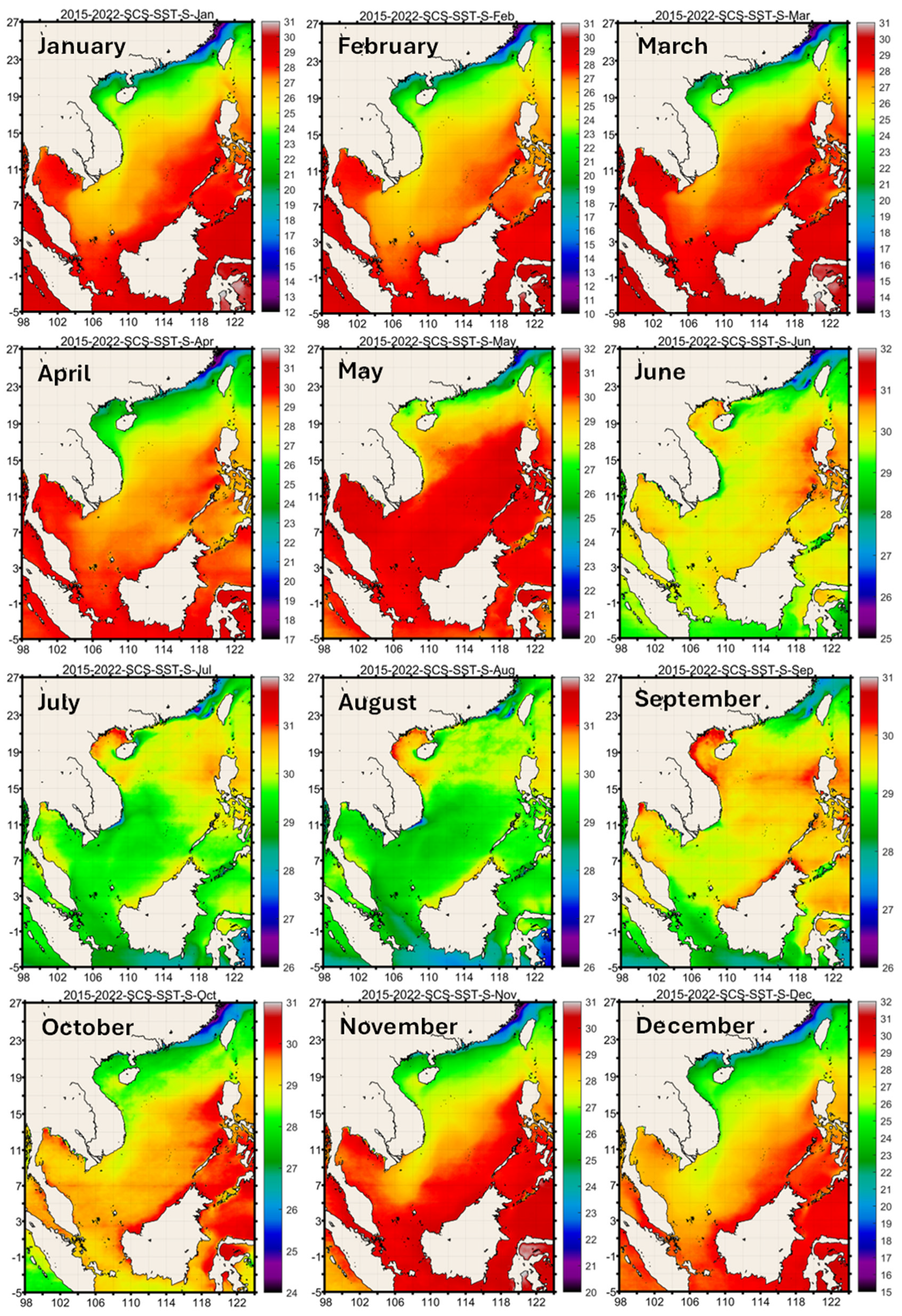
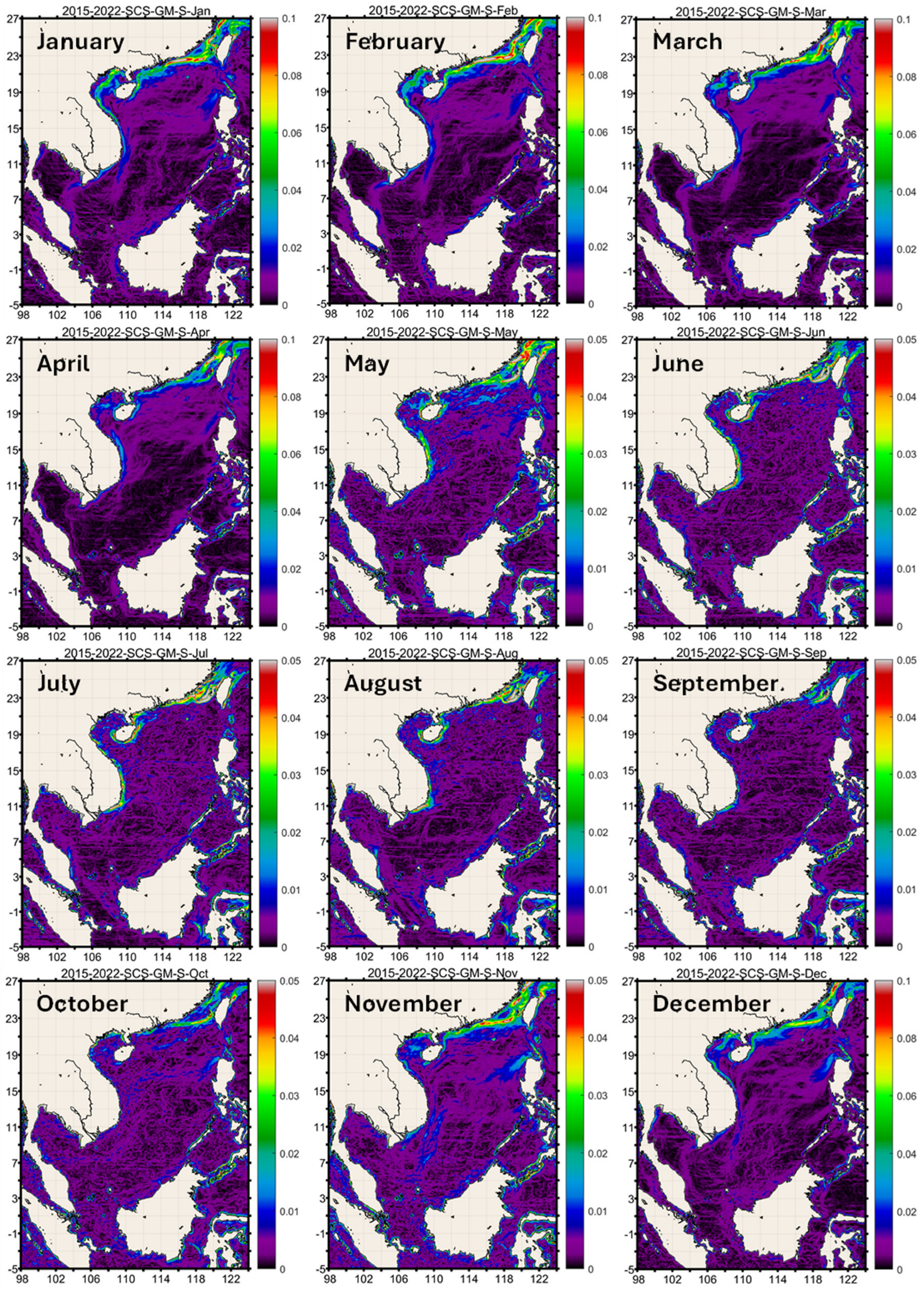
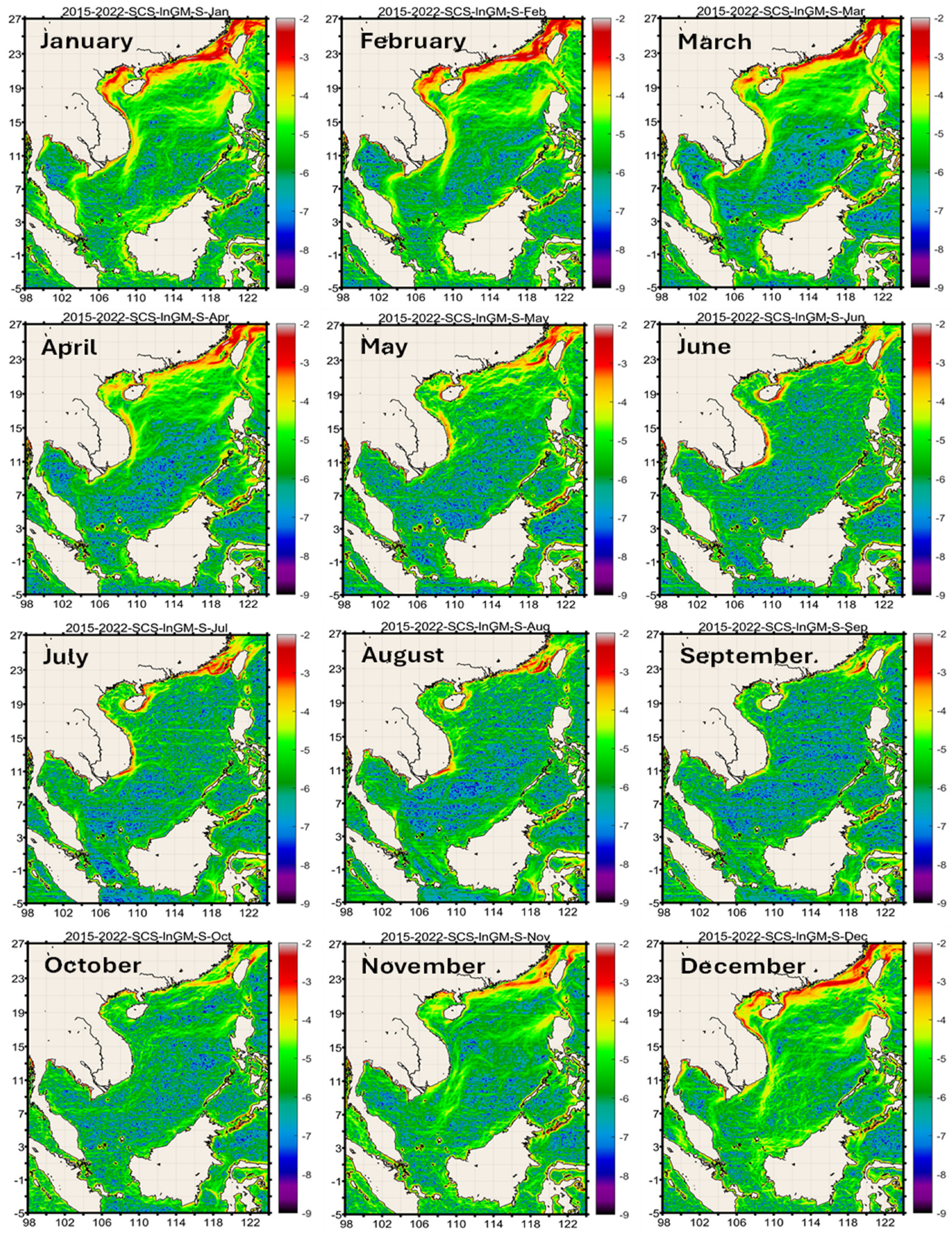
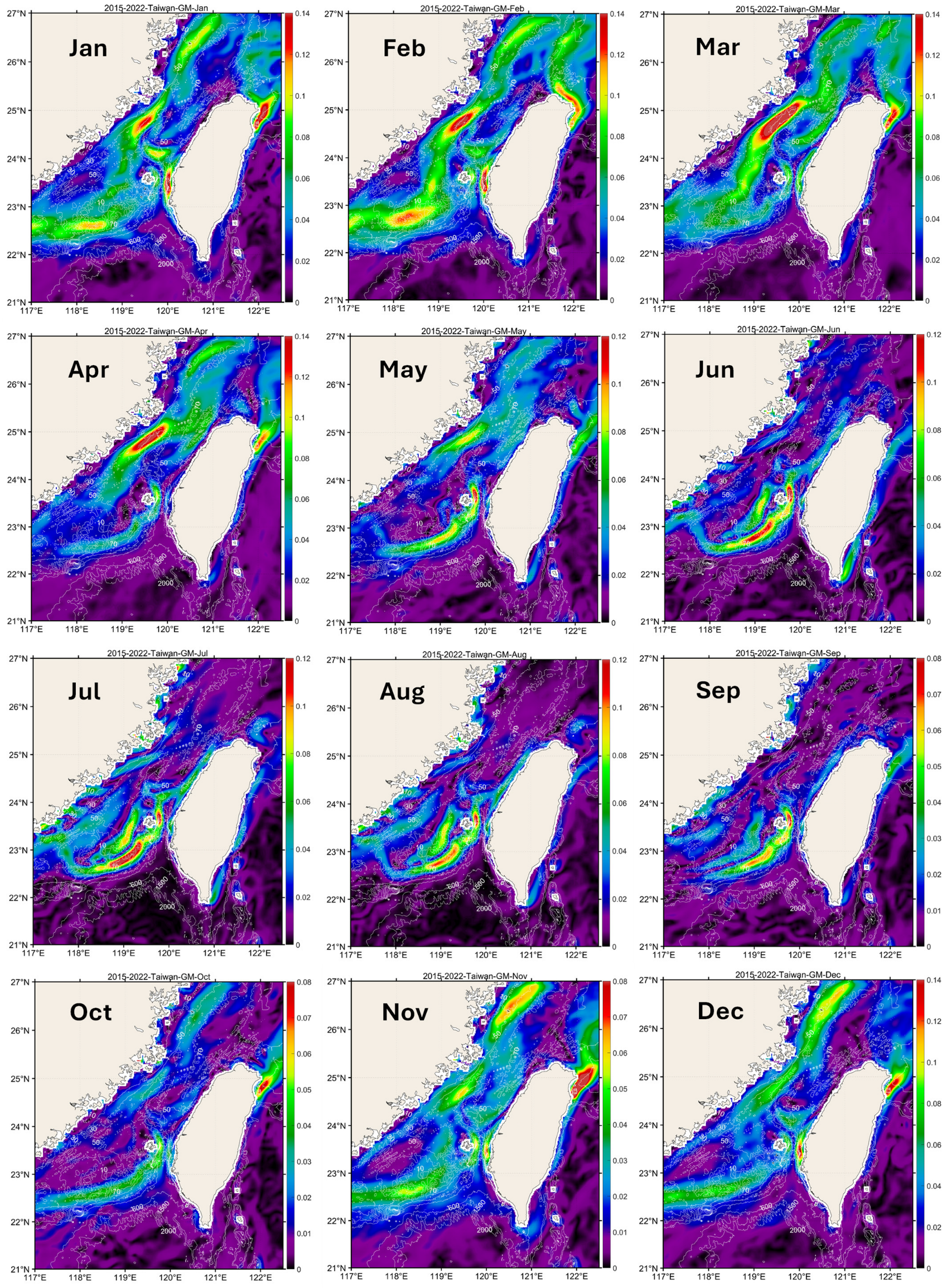
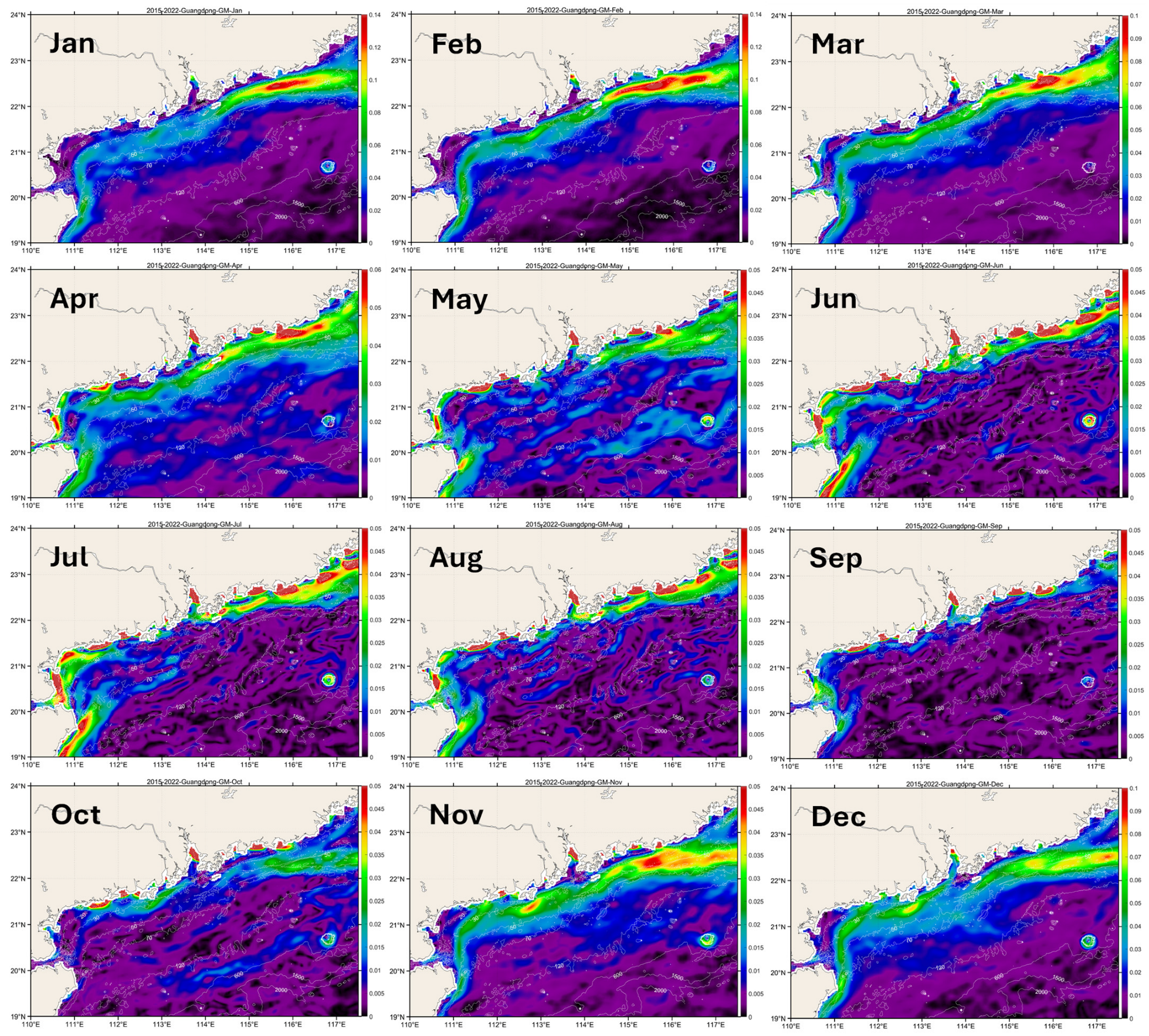


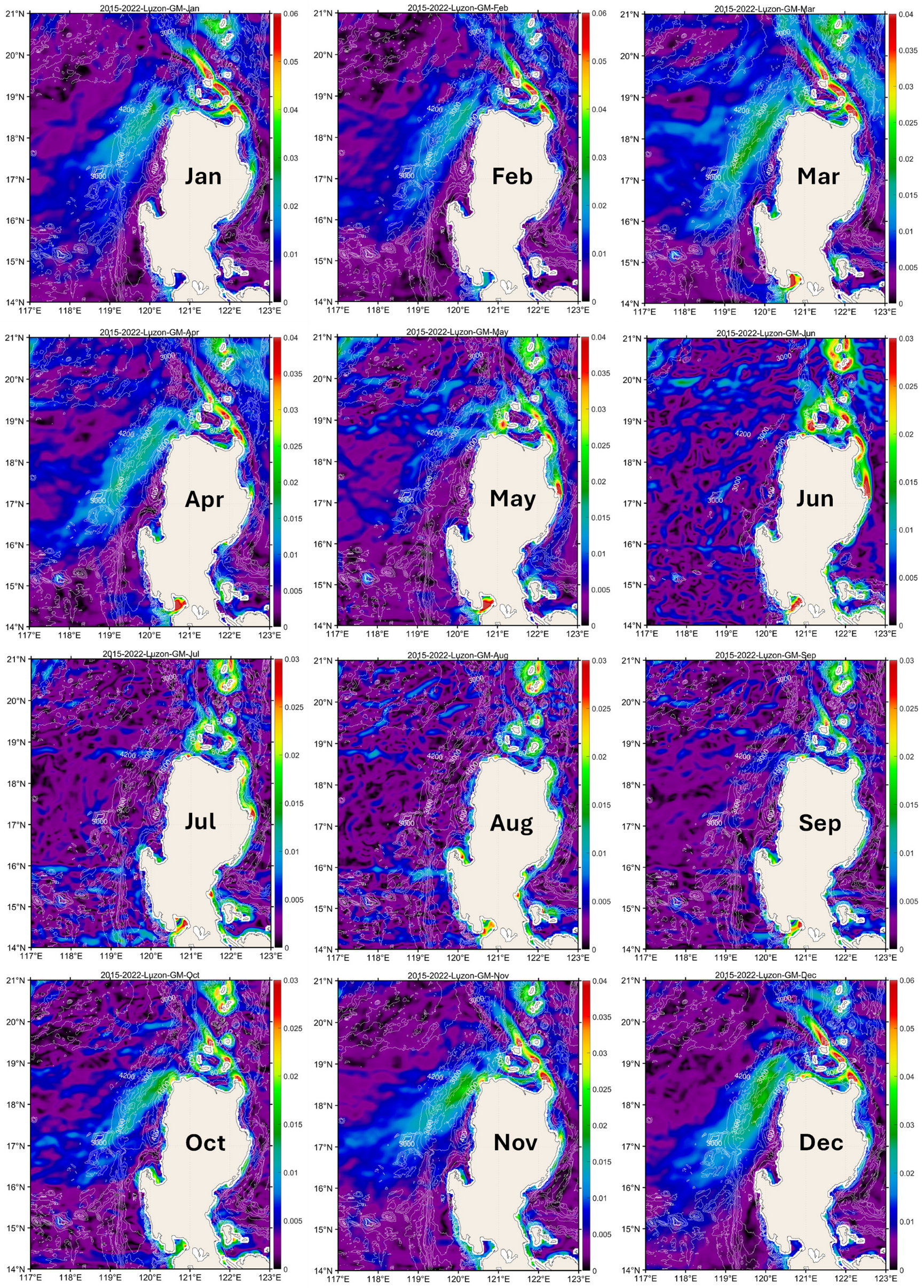


| Region | May SST (°C) | June SST (°C) | July SST (°C) | Cooling Magnitude (July SST–May SST) |
|---|---|---|---|---|
| West of Luzon | 30.7093 | 30.3820 | 30.0098 | 0.70 |
| Central SCS | 30.5234 | 29.9536 | 29.4660 | 1.07 |
| Gulf of Thailand | 30.6651 | 29.8138 | 29.5900 | 1.08 |
Disclaimer/Publisher’s Note: The statements, opinions and data contained in all publications are solely those of the individual author(s) and contributor(s) and not of MDPI and/or the editor(s). MDPI and/or the editor(s) disclaim responsibility for any injury to people or property resulting from any ideas, methods, instructions or products referred to in the content. |
© 2025 by the authors. Licensee MDPI, Basel, Switzerland. This article is an open access article distributed under the terms and conditions of the Creative Commons Attribution (CC BY) license (https://creativecommons.org/licenses/by/4.0/).
Share and Cite
Belkin, I.M.; Zang, Y.-T. South China Sea SST Fronts, 2015–2022. Remote Sens. 2025, 17, 817. https://doi.org/10.3390/rs17050817
Belkin IM, Zang Y-T. South China Sea SST Fronts, 2015–2022. Remote Sensing. 2025; 17(5):817. https://doi.org/10.3390/rs17050817
Chicago/Turabian StyleBelkin, Igor M., and Yi-Tao Zang. 2025. "South China Sea SST Fronts, 2015–2022" Remote Sensing 17, no. 5: 817. https://doi.org/10.3390/rs17050817
APA StyleBelkin, I. M., & Zang, Y.-T. (2025). South China Sea SST Fronts, 2015–2022. Remote Sensing, 17(5), 817. https://doi.org/10.3390/rs17050817






